Management and Operations Report: Marks and Spencer Analysis
VerifiedAdded on 2020/09/03
|14
|4098
|30
Report
AI Summary
This report provides an in-depth analysis of leadership and management within Marks and Spencer (M&S). It begins by defining the roles and characteristics of leaders and managers, highlighting their importance at different organizational levels and within the context of a retail environment. The report then explores the functions of managers and leaders, including decision-making, risk-taking, problem-solving, conflict resolution, time management, and training. It further delves into various leadership theories and models, such as situational, contingency, and system leadership, and their practical applications. The report concludes by examining key operational management approaches, including Total Quality Management, Just-in-Time inventories, and Six Sigma, analyzing the roles of leaders and managers in implementing these strategies to achieve business objectives and enhance customer satisfaction within M&S. The report emphasizes the importance of these approaches in achieving organizational goals.
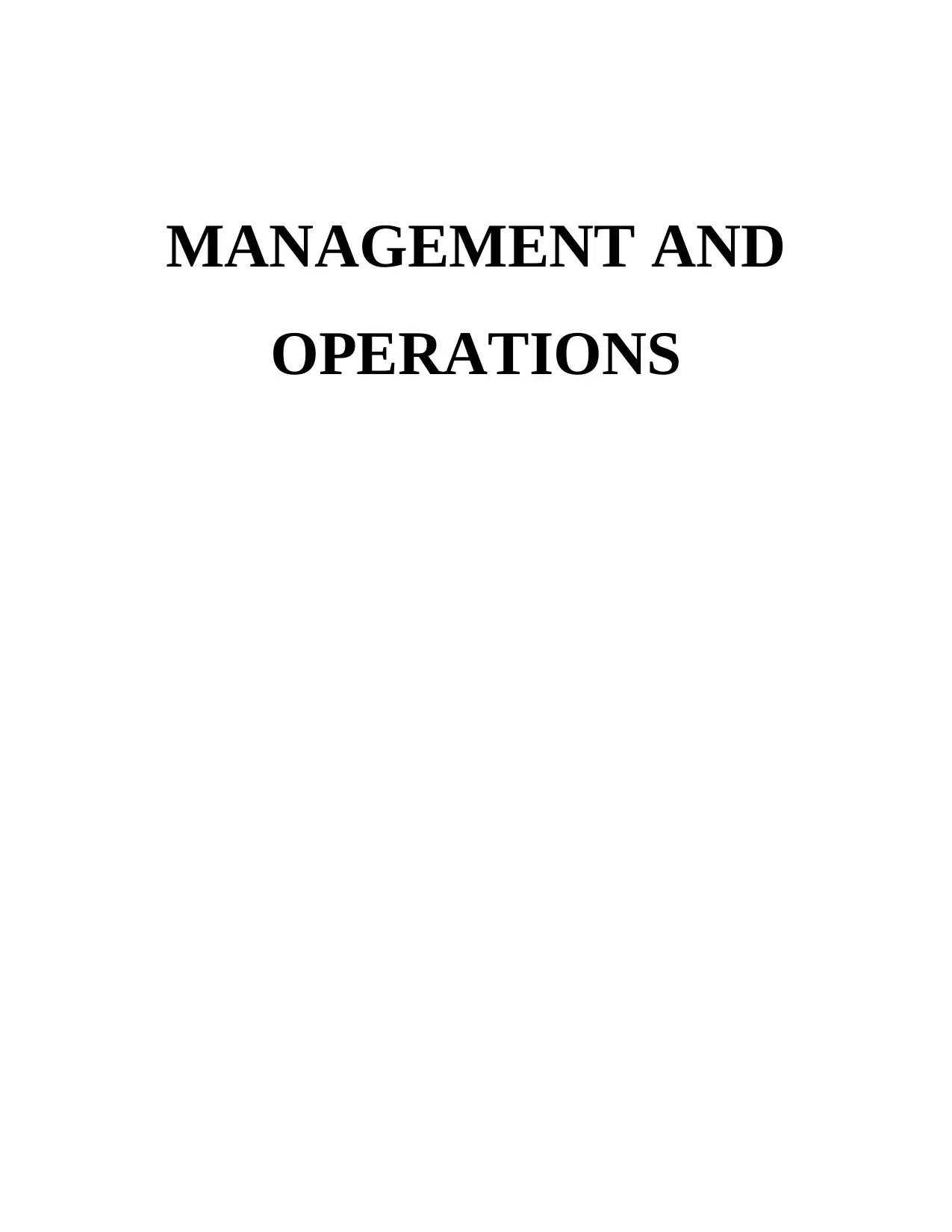
MANAGEMENT AND
OPERATIONS
OPERATIONS
Paraphrase This Document
Need a fresh take? Get an instant paraphrase of this document with our AI Paraphraser
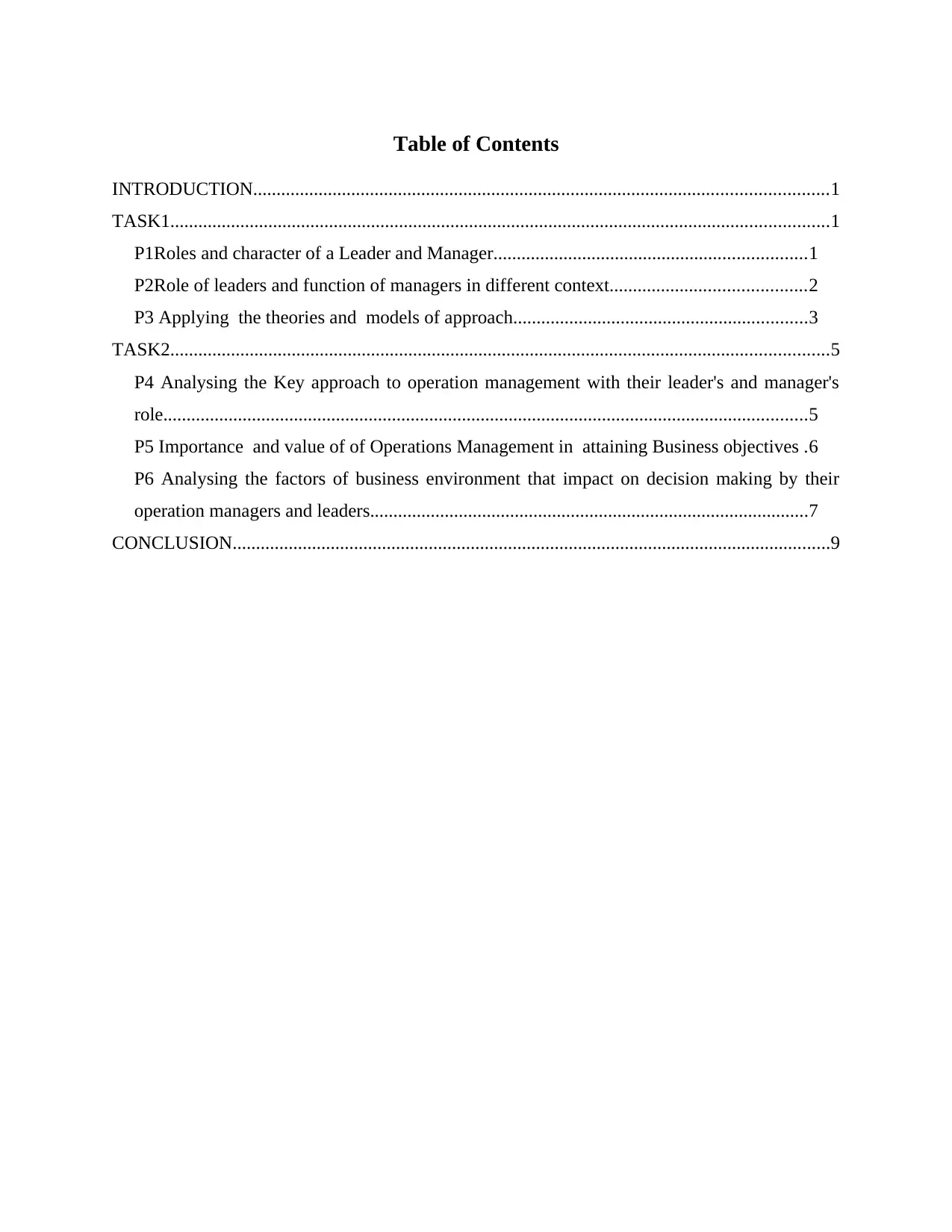
Table of Contents
INTRODUCTION...........................................................................................................................1
TASK1.............................................................................................................................................1
P1Roles and character of a Leader and Manager...................................................................1
P2Role of leaders and function of managers in different context..........................................2
P3 Applying the theories and models of approach...............................................................3
TASK2.............................................................................................................................................5
P4 Analysing the Key approach to operation management with their leader's and manager's
role..........................................................................................................................................5
P5 Importance and value of of Operations Management in attaining Business objectives .6
P6 Analysing the factors of business environment that impact on decision making by their
operation managers and leaders..............................................................................................7
CONCLUSION................................................................................................................................9
INTRODUCTION...........................................................................................................................1
TASK1.............................................................................................................................................1
P1Roles and character of a Leader and Manager...................................................................1
P2Role of leaders and function of managers in different context..........................................2
P3 Applying the theories and models of approach...............................................................3
TASK2.............................................................................................................................................5
P4 Analysing the Key approach to operation management with their leader's and manager's
role..........................................................................................................................................5
P5 Importance and value of of Operations Management in attaining Business objectives .6
P6 Analysing the factors of business environment that impact on decision making by their
operation managers and leaders..............................................................................................7
CONCLUSION................................................................................................................................9

⊘ This is a preview!⊘
Do you want full access?
Subscribe today to unlock all pages.

Trusted by 1+ million students worldwide
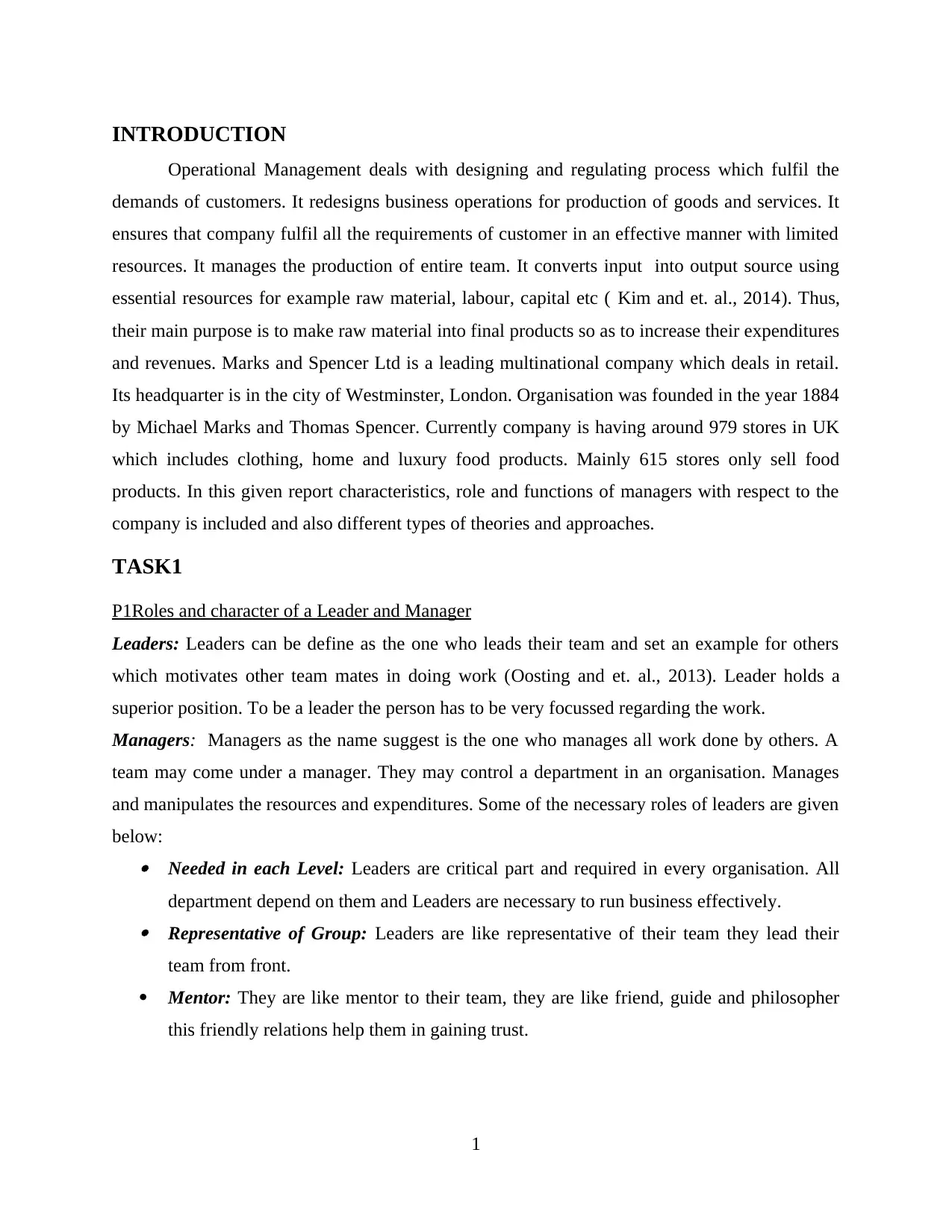
INTRODUCTION
Operational Management deals with designing and regulating process which fulfil the
demands of customers. It redesigns business operations for production of goods and services. It
ensures that company fulfil all the requirements of customer in an effective manner with limited
resources. It manages the production of entire team. It converts input into output source using
essential resources for example raw material, labour, capital etc ( Kim and et. al., 2014). Thus,
their main purpose is to make raw material into final products so as to increase their expenditures
and revenues. Marks and Spencer Ltd is a leading multinational company which deals in retail.
Its headquarter is in the city of Westminster, London. Organisation was founded in the year 1884
by Michael Marks and Thomas Spencer. Currently company is having around 979 stores in UK
which includes clothing, home and luxury food products. Mainly 615 stores only sell food
products. In this given report characteristics, role and functions of managers with respect to the
company is included and also different types of theories and approaches.
TASK1
P1Roles and character of a Leader and Manager
Leaders: Leaders can be define as the one who leads their team and set an example for others
which motivates other team mates in doing work (Oosting and et. al., 2013). Leader holds a
superior position. To be a leader the person has to be very focussed regarding the work.
Managers: Managers as the name suggest is the one who manages all work done by others. A
team may come under a manager. They may control a department in an organisation. Manages
and manipulates the resources and expenditures. Some of the necessary roles of leaders are given
below: Needed in each Level: Leaders are critical part and required in every organisation. All
department depend on them and Leaders are necessary to run business effectively. Representative of Group: Leaders are like representative of their team they lead their
team from front.
Mentor: They are like mentor to their team, they are like friend, guide and philosopher
this friendly relations help them in gaining trust.
1
Operational Management deals with designing and regulating process which fulfil the
demands of customers. It redesigns business operations for production of goods and services. It
ensures that company fulfil all the requirements of customer in an effective manner with limited
resources. It manages the production of entire team. It converts input into output source using
essential resources for example raw material, labour, capital etc ( Kim and et. al., 2014). Thus,
their main purpose is to make raw material into final products so as to increase their expenditures
and revenues. Marks and Spencer Ltd is a leading multinational company which deals in retail.
Its headquarter is in the city of Westminster, London. Organisation was founded in the year 1884
by Michael Marks and Thomas Spencer. Currently company is having around 979 stores in UK
which includes clothing, home and luxury food products. Mainly 615 stores only sell food
products. In this given report characteristics, role and functions of managers with respect to the
company is included and also different types of theories and approaches.
TASK1
P1Roles and character of a Leader and Manager
Leaders: Leaders can be define as the one who leads their team and set an example for others
which motivates other team mates in doing work (Oosting and et. al., 2013). Leader holds a
superior position. To be a leader the person has to be very focussed regarding the work.
Managers: Managers as the name suggest is the one who manages all work done by others. A
team may come under a manager. They may control a department in an organisation. Manages
and manipulates the resources and expenditures. Some of the necessary roles of leaders are given
below: Needed in each Level: Leaders are critical part and required in every organisation. All
department depend on them and Leaders are necessary to run business effectively. Representative of Group: Leaders are like representative of their team they lead their
team from front.
Mentor: They are like mentor to their team, they are like friend, guide and philosopher
this friendly relations help them in gaining trust.
1
Paraphrase This Document
Need a fresh take? Get an instant paraphrase of this document with our AI Paraphraser
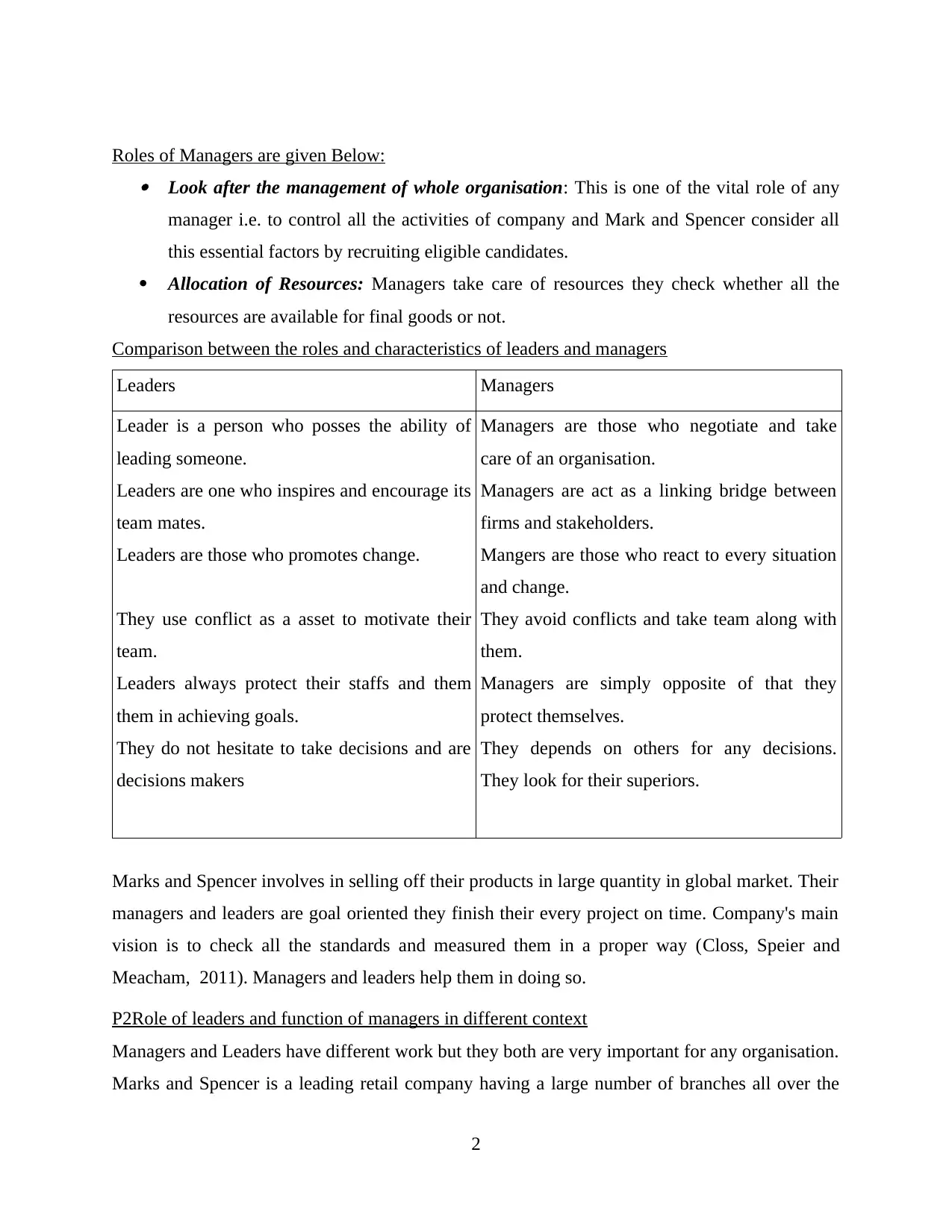
Roles of Managers are given Below: Look after the management of whole organisation: This is one of the vital role of any
manager i.e. to control all the activities of company and Mark and Spencer consider all
this essential factors by recruiting eligible candidates.
Allocation of Resources: Managers take care of resources they check whether all the
resources are available for final goods or not.
Comparison between the roles and characteristics of leaders and managers
Leaders Managers
Leader is a person who posses the ability of
leading someone.
Leaders are one who inspires and encourage its
team mates.
Leaders are those who promotes change.
They use conflict as a asset to motivate their
team.
Leaders always protect their staffs and them
them in achieving goals.
They do not hesitate to take decisions and are
decisions makers
Managers are those who negotiate and take
care of an organisation.
Managers are act as a linking bridge between
firms and stakeholders.
Mangers are those who react to every situation
and change.
They avoid conflicts and take team along with
them.
Managers are simply opposite of that they
protect themselves.
They depends on others for any decisions.
They look for their superiors.
Marks and Spencer involves in selling off their products in large quantity in global market. Their
managers and leaders are goal oriented they finish their every project on time. Company's main
vision is to check all the standards and measured them in a proper way (Closs, Speier and
Meacham, 2011). Managers and leaders help them in doing so.
P2Role of leaders and function of managers in different context
Managers and Leaders have different work but they both are very important for any organisation.
Marks and Spencer is a leading retail company having a large number of branches all over the
2
manager i.e. to control all the activities of company and Mark and Spencer consider all
this essential factors by recruiting eligible candidates.
Allocation of Resources: Managers take care of resources they check whether all the
resources are available for final goods or not.
Comparison between the roles and characteristics of leaders and managers
Leaders Managers
Leader is a person who posses the ability of
leading someone.
Leaders are one who inspires and encourage its
team mates.
Leaders are those who promotes change.
They use conflict as a asset to motivate their
team.
Leaders always protect their staffs and them
them in achieving goals.
They do not hesitate to take decisions and are
decisions makers
Managers are those who negotiate and take
care of an organisation.
Managers are act as a linking bridge between
firms and stakeholders.
Mangers are those who react to every situation
and change.
They avoid conflicts and take team along with
them.
Managers are simply opposite of that they
protect themselves.
They depends on others for any decisions.
They look for their superiors.
Marks and Spencer involves in selling off their products in large quantity in global market. Their
managers and leaders are goal oriented they finish their every project on time. Company's main
vision is to check all the standards and measured them in a proper way (Closs, Speier and
Meacham, 2011). Managers and leaders help them in doing so.
P2Role of leaders and function of managers in different context
Managers and Leaders have different work but they both are very important for any organisation.
Marks and Spencer is a leading retail company having a large number of branches all over the
2
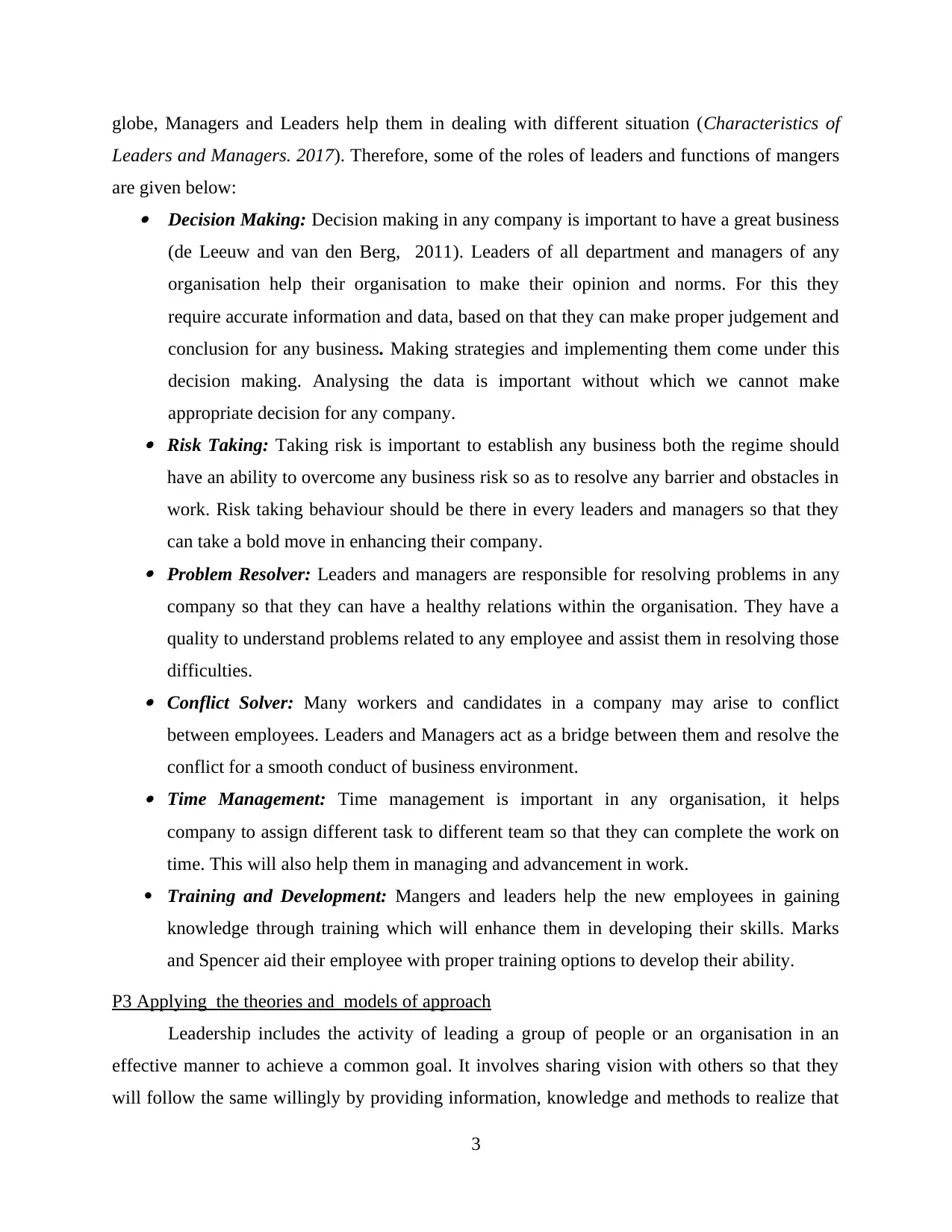
globe, Managers and Leaders help them in dealing with different situation (Characteristics of
Leaders and Managers. 2017). Therefore, some of the roles of leaders and functions of mangers
are given below: Decision Making: Decision making in any company is important to have a great business
(de Leeuw and van den Berg, 2011). Leaders of all department and managers of any
organisation help their organisation to make their opinion and norms. For this they
require accurate information and data, based on that they can make proper judgement and
conclusion for any business. Making strategies and implementing them come under this
decision making. Analysing the data is important without which we cannot make
appropriate decision for any company. Risk Taking: Taking risk is important to establish any business both the regime should
have an ability to overcome any business risk so as to resolve any barrier and obstacles in
work. Risk taking behaviour should be there in every leaders and managers so that they
can take a bold move in enhancing their company. Problem Resolver: Leaders and managers are responsible for resolving problems in any
company so that they can have a healthy relations within the organisation. They have a
quality to understand problems related to any employee and assist them in resolving those
difficulties. Conflict Solver: Many workers and candidates in a company may arise to conflict
between employees. Leaders and Managers act as a bridge between them and resolve the
conflict for a smooth conduct of business environment. Time Management: Time management is important in any organisation, it helps
company to assign different task to different team so that they can complete the work on
time. This will also help them in managing and advancement in work.
Training and Development: Mangers and leaders help the new employees in gaining
knowledge through training which will enhance them in developing their skills. Marks
and Spencer aid their employee with proper training options to develop their ability.
P3 Applying the theories and models of approach
Leadership includes the activity of leading a group of people or an organisation in an
effective manner to achieve a common goal. It involves sharing vision with others so that they
will follow the same willingly by providing information, knowledge and methods to realize that
3
Leaders and Managers. 2017). Therefore, some of the roles of leaders and functions of mangers
are given below: Decision Making: Decision making in any company is important to have a great business
(de Leeuw and van den Berg, 2011). Leaders of all department and managers of any
organisation help their organisation to make their opinion and norms. For this they
require accurate information and data, based on that they can make proper judgement and
conclusion for any business. Making strategies and implementing them come under this
decision making. Analysing the data is important without which we cannot make
appropriate decision for any company. Risk Taking: Taking risk is important to establish any business both the regime should
have an ability to overcome any business risk so as to resolve any barrier and obstacles in
work. Risk taking behaviour should be there in every leaders and managers so that they
can take a bold move in enhancing their company. Problem Resolver: Leaders and managers are responsible for resolving problems in any
company so that they can have a healthy relations within the organisation. They have a
quality to understand problems related to any employee and assist them in resolving those
difficulties. Conflict Solver: Many workers and candidates in a company may arise to conflict
between employees. Leaders and Managers act as a bridge between them and resolve the
conflict for a smooth conduct of business environment. Time Management: Time management is important in any organisation, it helps
company to assign different task to different team so that they can complete the work on
time. This will also help them in managing and advancement in work.
Training and Development: Mangers and leaders help the new employees in gaining
knowledge through training which will enhance them in developing their skills. Marks
and Spencer aid their employee with proper training options to develop their ability.
P3 Applying the theories and models of approach
Leadership includes the activity of leading a group of people or an organisation in an
effective manner to achieve a common goal. It involves sharing vision with others so that they
will follow the same willingly by providing information, knowledge and methods to realize that
3
⊘ This is a preview!⊘
Do you want full access?
Subscribe today to unlock all pages.

Trusted by 1+ million students worldwide
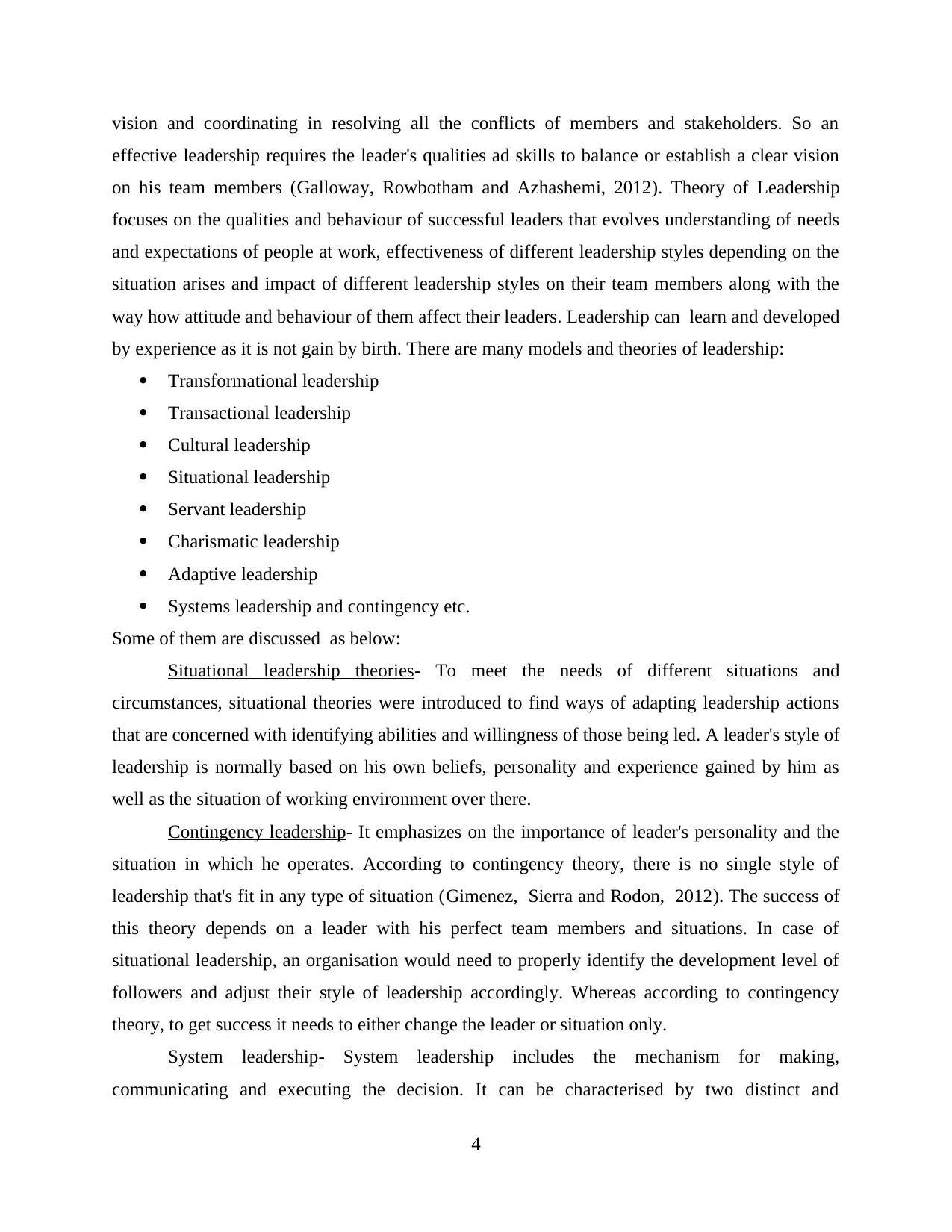
vision and coordinating in resolving all the conflicts of members and stakeholders. So an
effective leadership requires the leader's qualities ad skills to balance or establish a clear vision
on his team members (Galloway, Rowbotham and Azhashemi, 2012). Theory of Leadership
focuses on the qualities and behaviour of successful leaders that evolves understanding of needs
and expectations of people at work, effectiveness of different leadership styles depending on the
situation arises and impact of different leadership styles on their team members along with the
way how attitude and behaviour of them affect their leaders. Leadership can learn and developed
by experience as it is not gain by birth. There are many models and theories of leadership:
Transformational leadership
Transactional leadership
Cultural leadership
Situational leadership
Servant leadership
Charismatic leadership
Adaptive leadership
Systems leadership and contingency etc.
Some of them are discussed as below:
Situational leadership theories- To meet the needs of different situations and
circumstances, situational theories were introduced to find ways of adapting leadership actions
that are concerned with identifying abilities and willingness of those being led. A leader's style of
leadership is normally based on his own beliefs, personality and experience gained by him as
well as the situation of working environment over there.
Contingency leadership- It emphasizes on the importance of leader's personality and the
situation in which he operates. According to contingency theory, there is no single style of
leadership that's fit in any type of situation (Gimenez, Sierra and Rodon, 2012). The success of
this theory depends on a leader with his perfect team members and situations. In case of
situational leadership, an organisation would need to properly identify the development level of
followers and adjust their style of leadership accordingly. Whereas according to contingency
theory, to get success it needs to either change the leader or situation only.
System leadership- System leadership includes the mechanism for making,
communicating and executing the decision. It can be characterised by two distinct and
4
effective leadership requires the leader's qualities ad skills to balance or establish a clear vision
on his team members (Galloway, Rowbotham and Azhashemi, 2012). Theory of Leadership
focuses on the qualities and behaviour of successful leaders that evolves understanding of needs
and expectations of people at work, effectiveness of different leadership styles depending on the
situation arises and impact of different leadership styles on their team members along with the
way how attitude and behaviour of them affect their leaders. Leadership can learn and developed
by experience as it is not gain by birth. There are many models and theories of leadership:
Transformational leadership
Transactional leadership
Cultural leadership
Situational leadership
Servant leadership
Charismatic leadership
Adaptive leadership
Systems leadership and contingency etc.
Some of them are discussed as below:
Situational leadership theories- To meet the needs of different situations and
circumstances, situational theories were introduced to find ways of adapting leadership actions
that are concerned with identifying abilities and willingness of those being led. A leader's style of
leadership is normally based on his own beliefs, personality and experience gained by him as
well as the situation of working environment over there.
Contingency leadership- It emphasizes on the importance of leader's personality and the
situation in which he operates. According to contingency theory, there is no single style of
leadership that's fit in any type of situation (Gimenez, Sierra and Rodon, 2012). The success of
this theory depends on a leader with his perfect team members and situations. In case of
situational leadership, an organisation would need to properly identify the development level of
followers and adjust their style of leadership accordingly. Whereas according to contingency
theory, to get success it needs to either change the leader or situation only.
System leadership- System leadership includes the mechanism for making,
communicating and executing the decision. It can be characterised by two distinct and
4
Paraphrase This Document
Need a fresh take? Get an instant paraphrase of this document with our AI Paraphraser
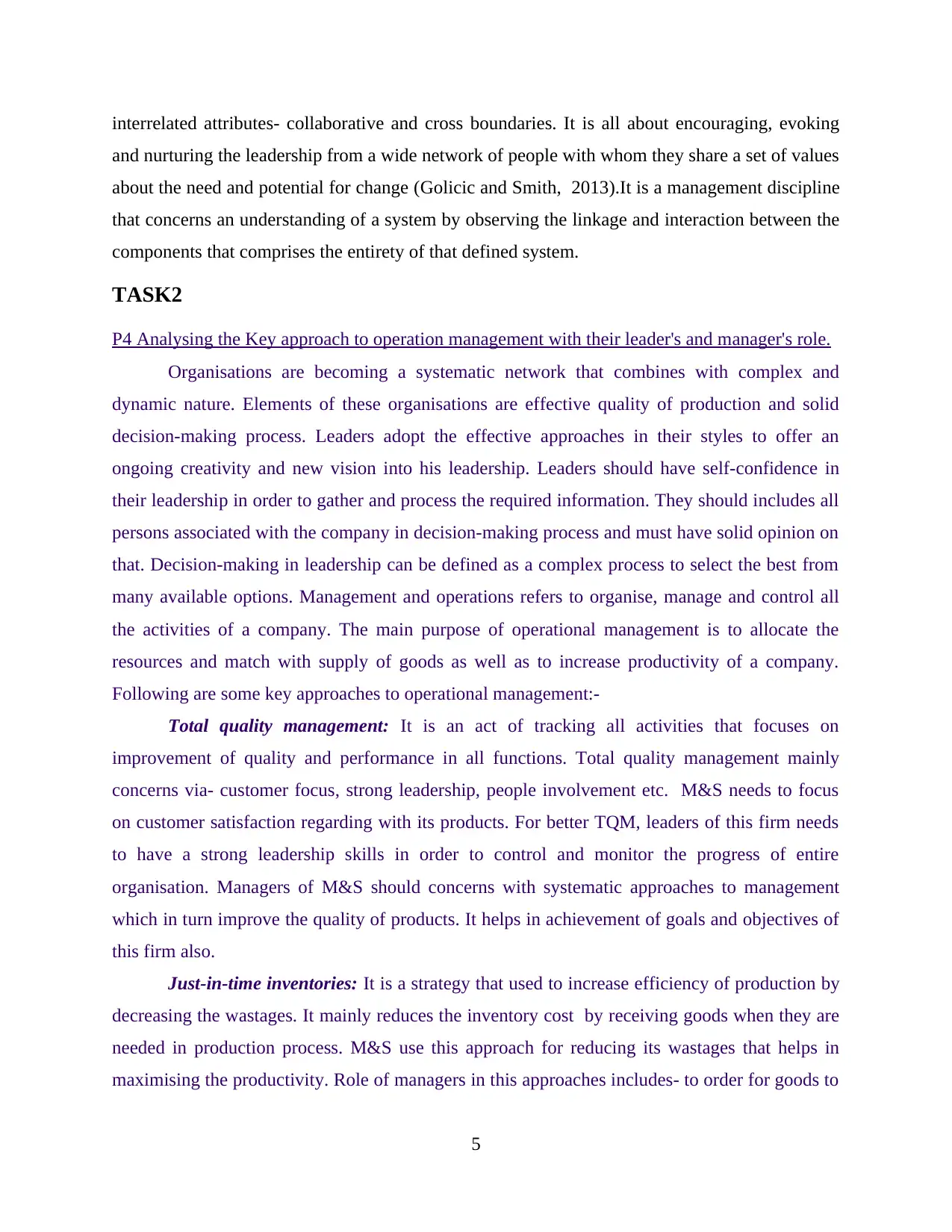
interrelated attributes- collaborative and cross boundaries. It is all about encouraging, evoking
and nurturing the leadership from a wide network of people with whom they share a set of values
about the need and potential for change (Golicic and Smith, 2013).It is a management discipline
that concerns an understanding of a system by observing the linkage and interaction between the
components that comprises the entirety of that defined system.
TASK2
P4 Analysing the Key approach to operation management with their leader's and manager's role.
Organisations are becoming a systematic network that combines with complex and
dynamic nature. Elements of these organisations are effective quality of production and solid
decision-making process. Leaders adopt the effective approaches in their styles to offer an
ongoing creativity and new vision into his leadership. Leaders should have self-confidence in
their leadership in order to gather and process the required information. They should includes all
persons associated with the company in decision-making process and must have solid opinion on
that. Decision-making in leadership can be defined as a complex process to select the best from
many available options. Management and operations refers to organise, manage and control all
the activities of a company. The main purpose of operational management is to allocate the
resources and match with supply of goods as well as to increase productivity of a company.
Following are some key approaches to operational management:-
Total quality management: It is an act of tracking all activities that focuses on
improvement of quality and performance in all functions. Total quality management mainly
concerns via- customer focus, strong leadership, people involvement etc. M&S needs to focus
on customer satisfaction regarding with its products. For better TQM, leaders of this firm needs
to have a strong leadership skills in order to control and monitor the progress of entire
organisation. Managers of M&S should concerns with systematic approaches to management
which in turn improve the quality of products. It helps in achievement of goals and objectives of
this firm also.
Just-in-time inventories: It is a strategy that used to increase efficiency of production by
decreasing the wastages. It mainly reduces the inventory cost by receiving goods when they are
needed in production process. M&S use this approach for reducing its wastages that helps in
maximising the productivity. Role of managers in this approaches includes- to order for goods to
5
and nurturing the leadership from a wide network of people with whom they share a set of values
about the need and potential for change (Golicic and Smith, 2013).It is a management discipline
that concerns an understanding of a system by observing the linkage and interaction between the
components that comprises the entirety of that defined system.
TASK2
P4 Analysing the Key approach to operation management with their leader's and manager's role.
Organisations are becoming a systematic network that combines with complex and
dynamic nature. Elements of these organisations are effective quality of production and solid
decision-making process. Leaders adopt the effective approaches in their styles to offer an
ongoing creativity and new vision into his leadership. Leaders should have self-confidence in
their leadership in order to gather and process the required information. They should includes all
persons associated with the company in decision-making process and must have solid opinion on
that. Decision-making in leadership can be defined as a complex process to select the best from
many available options. Management and operations refers to organise, manage and control all
the activities of a company. The main purpose of operational management is to allocate the
resources and match with supply of goods as well as to increase productivity of a company.
Following are some key approaches to operational management:-
Total quality management: It is an act of tracking all activities that focuses on
improvement of quality and performance in all functions. Total quality management mainly
concerns via- customer focus, strong leadership, people involvement etc. M&S needs to focus
on customer satisfaction regarding with its products. For better TQM, leaders of this firm needs
to have a strong leadership skills in order to control and monitor the progress of entire
organisation. Managers of M&S should concerns with systematic approaches to management
which in turn improve the quality of products. It helps in achievement of goals and objectives of
this firm also.
Just-in-time inventories: It is a strategy that used to increase efficiency of production by
decreasing the wastages. It mainly reduces the inventory cost by receiving goods when they are
needed in production process. M&S use this approach for reducing its wastages that helps in
maximising the productivity. Role of managers in this approaches includes- to order for goods to
5
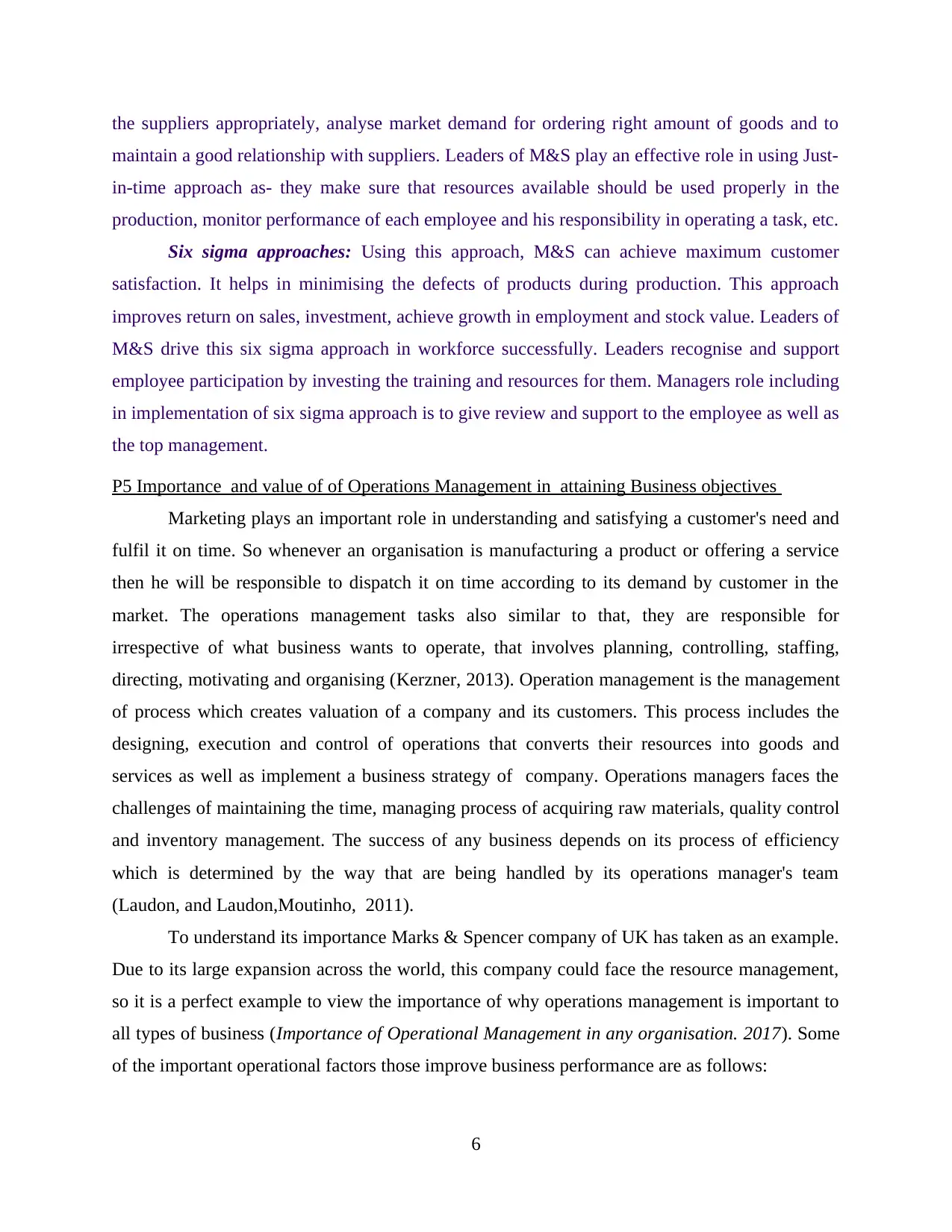
the suppliers appropriately, analyse market demand for ordering right amount of goods and to
maintain a good relationship with suppliers. Leaders of M&S play an effective role in using Just-
in-time approach as- they make sure that resources available should be used properly in the
production, monitor performance of each employee and his responsibility in operating a task, etc.
Six sigma approaches: Using this approach, M&S can achieve maximum customer
satisfaction. It helps in minimising the defects of products during production. This approach
improves return on sales, investment, achieve growth in employment and stock value. Leaders of
M&S drive this six sigma approach in workforce successfully. Leaders recognise and support
employee participation by investing the training and resources for them. Managers role including
in implementation of six sigma approach is to give review and support to the employee as well as
the top management.
P5 Importance and value of of Operations Management in attaining Business objectives
Marketing plays an important role in understanding and satisfying a customer's need and
fulfil it on time. So whenever an organisation is manufacturing a product or offering a service
then he will be responsible to dispatch it on time according to its demand by customer in the
market. The operations management tasks also similar to that, they are responsible for
irrespective of what business wants to operate, that involves planning, controlling, staffing,
directing, motivating and organising (Kerzner, 2013). Operation management is the management
of process which creates valuation of a company and its customers. This process includes the
designing, execution and control of operations that converts their resources into goods and
services as well as implement a business strategy of company. Operations managers faces the
challenges of maintaining the time, managing process of acquiring raw materials, quality control
and inventory management. The success of any business depends on its process of efficiency
which is determined by the way that are being handled by its operations manager's team
(Laudon, and Laudon,Moutinho, 2011).
To understand its importance Marks & Spencer company of UK has taken as an example.
Due to its large expansion across the world, this company could face the resource management,
so it is a perfect example to view the importance of why operations management is important to
all types of business (Importance of Operational Management in any organisation. 2017). Some
of the important operational factors those improve business performance are as follows:
6
maintain a good relationship with suppliers. Leaders of M&S play an effective role in using Just-
in-time approach as- they make sure that resources available should be used properly in the
production, monitor performance of each employee and his responsibility in operating a task, etc.
Six sigma approaches: Using this approach, M&S can achieve maximum customer
satisfaction. It helps in minimising the defects of products during production. This approach
improves return on sales, investment, achieve growth in employment and stock value. Leaders of
M&S drive this six sigma approach in workforce successfully. Leaders recognise and support
employee participation by investing the training and resources for them. Managers role including
in implementation of six sigma approach is to give review and support to the employee as well as
the top management.
P5 Importance and value of of Operations Management in attaining Business objectives
Marketing plays an important role in understanding and satisfying a customer's need and
fulfil it on time. So whenever an organisation is manufacturing a product or offering a service
then he will be responsible to dispatch it on time according to its demand by customer in the
market. The operations management tasks also similar to that, they are responsible for
irrespective of what business wants to operate, that involves planning, controlling, staffing,
directing, motivating and organising (Kerzner, 2013). Operation management is the management
of process which creates valuation of a company and its customers. This process includes the
designing, execution and control of operations that converts their resources into goods and
services as well as implement a business strategy of company. Operations managers faces the
challenges of maintaining the time, managing process of acquiring raw materials, quality control
and inventory management. The success of any business depends on its process of efficiency
which is determined by the way that are being handled by its operations manager's team
(Laudon, and Laudon,Moutinho, 2011).
To understand its importance Marks & Spencer company of UK has taken as an example.
Due to its large expansion across the world, this company could face the resource management,
so it is a perfect example to view the importance of why operations management is important to
all types of business (Importance of Operational Management in any organisation. 2017). Some
of the important operational factors those improve business performance are as follows:
6
⊘ This is a preview!⊘
Do you want full access?
Subscribe today to unlock all pages.

Trusted by 1+ million students worldwide
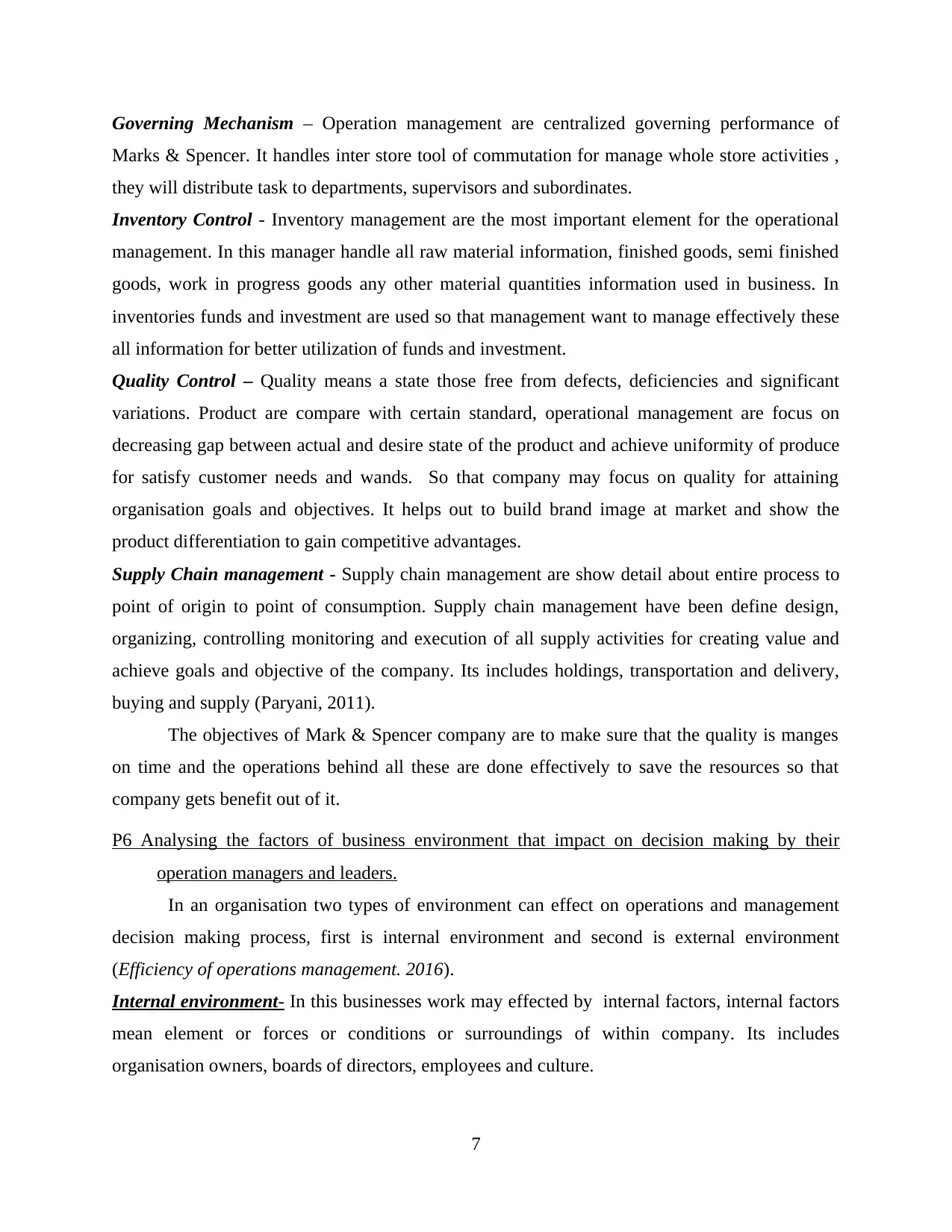
Governing Mechanism – Operation management are centralized governing performance of
Marks & Spencer. It handles inter store tool of commutation for manage whole store activities ,
they will distribute task to departments, supervisors and subordinates.
Inventory Control - Inventory management are the most important element for the operational
management. In this manager handle all raw material information, finished goods, semi finished
goods, work in progress goods any other material quantities information used in business. In
inventories funds and investment are used so that management want to manage effectively these
all information for better utilization of funds and investment.
Quality Control – Quality means a state those free from defects, deficiencies and significant
variations. Product are compare with certain standard, operational management are focus on
decreasing gap between actual and desire state of the product and achieve uniformity of produce
for satisfy customer needs and wands. So that company may focus on quality for attaining
organisation goals and objectives. It helps out to build brand image at market and show the
product differentiation to gain competitive advantages.
Supply Chain management - Supply chain management are show detail about entire process to
point of origin to point of consumption. Supply chain management have been define design,
organizing, controlling monitoring and execution of all supply activities for creating value and
achieve goals and objective of the company. Its includes holdings, transportation and delivery,
buying and supply (Paryani, 2011).
The objectives of Mark & Spencer company are to make sure that the quality is manges
on time and the operations behind all these are done effectively to save the resources so that
company gets benefit out of it.
P6 Analysing the factors of business environment that impact on decision making by their
operation managers and leaders.
In an organisation two types of environment can effect on operations and management
decision making process, first is internal environment and second is external environment
(Efficiency of operations management. 2016).
Internal environment- In this businesses work may effected by internal factors, internal factors
mean element or forces or conditions or surroundings of within company. Its includes
organisation owners, boards of directors, employees and culture.
7
Marks & Spencer. It handles inter store tool of commutation for manage whole store activities ,
they will distribute task to departments, supervisors and subordinates.
Inventory Control - Inventory management are the most important element for the operational
management. In this manager handle all raw material information, finished goods, semi finished
goods, work in progress goods any other material quantities information used in business. In
inventories funds and investment are used so that management want to manage effectively these
all information for better utilization of funds and investment.
Quality Control – Quality means a state those free from defects, deficiencies and significant
variations. Product are compare with certain standard, operational management are focus on
decreasing gap between actual and desire state of the product and achieve uniformity of produce
for satisfy customer needs and wands. So that company may focus on quality for attaining
organisation goals and objectives. It helps out to build brand image at market and show the
product differentiation to gain competitive advantages.
Supply Chain management - Supply chain management are show detail about entire process to
point of origin to point of consumption. Supply chain management have been define design,
organizing, controlling monitoring and execution of all supply activities for creating value and
achieve goals and objective of the company. Its includes holdings, transportation and delivery,
buying and supply (Paryani, 2011).
The objectives of Mark & Spencer company are to make sure that the quality is manges
on time and the operations behind all these are done effectively to save the resources so that
company gets benefit out of it.
P6 Analysing the factors of business environment that impact on decision making by their
operation managers and leaders.
In an organisation two types of environment can effect on operations and management
decision making process, first is internal environment and second is external environment
(Efficiency of operations management. 2016).
Internal environment- In this businesses work may effected by internal factors, internal factors
mean element or forces or conditions or surroundings of within company. Its includes
organisation owners, boards of directors, employees and culture.
7
Paraphrase This Document
Need a fresh take? Get an instant paraphrase of this document with our AI Paraphraser
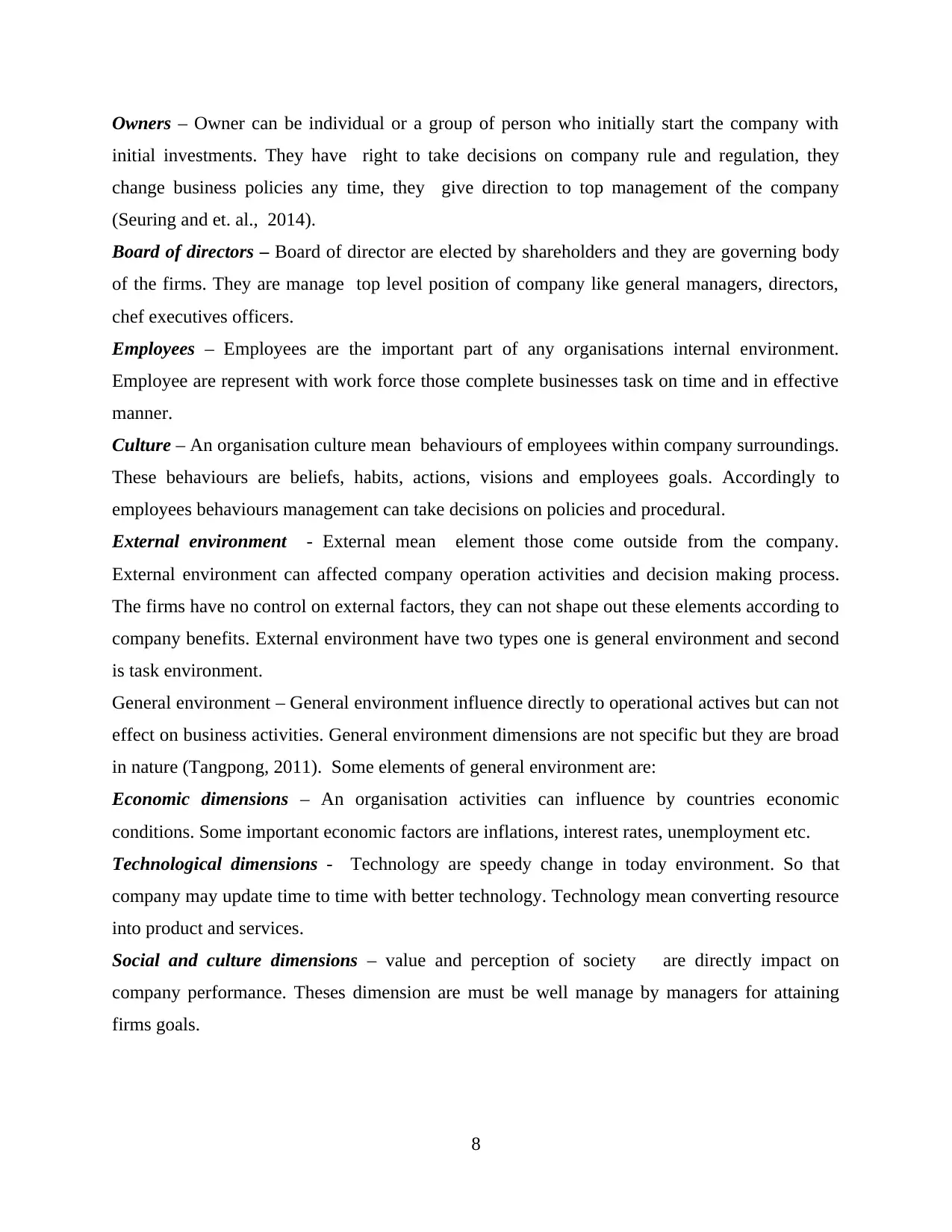
Owners – Owner can be individual or a group of person who initially start the company with
initial investments. They have right to take decisions on company rule and regulation, they
change business policies any time, they give direction to top management of the company
(Seuring and et. al., 2014).
Board of directors – Board of director are elected by shareholders and they are governing body
of the firms. They are manage top level position of company like general managers, directors,
chef executives officers.
Employees – Employees are the important part of any organisations internal environment.
Employee are represent with work force those complete businesses task on time and in effective
manner.
Culture – An organisation culture mean behaviours of employees within company surroundings.
These behaviours are beliefs, habits, actions, visions and employees goals. Accordingly to
employees behaviours management can take decisions on policies and procedural.
External environment - External mean element those come outside from the company.
External environment can affected company operation activities and decision making process.
The firms have no control on external factors, they can not shape out these elements according to
company benefits. External environment have two types one is general environment and second
is task environment.
General environment – General environment influence directly to operational actives but can not
effect on business activities. General environment dimensions are not specific but they are broad
in nature (Tangpong, 2011). Some elements of general environment are:
Economic dimensions – An organisation activities can influence by countries economic
conditions. Some important economic factors are inflations, interest rates, unemployment etc.
Technological dimensions - Technology are speedy change in today environment. So that
company may update time to time with better technology. Technology mean converting resource
into product and services.
Social and culture dimensions – value and perception of society are directly impact on
company performance. Theses dimension are must be well manage by managers for attaining
firms goals.
8
initial investments. They have right to take decisions on company rule and regulation, they
change business policies any time, they give direction to top management of the company
(Seuring and et. al., 2014).
Board of directors – Board of director are elected by shareholders and they are governing body
of the firms. They are manage top level position of company like general managers, directors,
chef executives officers.
Employees – Employees are the important part of any organisations internal environment.
Employee are represent with work force those complete businesses task on time and in effective
manner.
Culture – An organisation culture mean behaviours of employees within company surroundings.
These behaviours are beliefs, habits, actions, visions and employees goals. Accordingly to
employees behaviours management can take decisions on policies and procedural.
External environment - External mean element those come outside from the company.
External environment can affected company operation activities and decision making process.
The firms have no control on external factors, they can not shape out these elements according to
company benefits. External environment have two types one is general environment and second
is task environment.
General environment – General environment influence directly to operational actives but can not
effect on business activities. General environment dimensions are not specific but they are broad
in nature (Tangpong, 2011). Some elements of general environment are:
Economic dimensions – An organisation activities can influence by countries economic
conditions. Some important economic factors are inflations, interest rates, unemployment etc.
Technological dimensions - Technology are speedy change in today environment. So that
company may update time to time with better technology. Technology mean converting resource
into product and services.
Social and culture dimensions – value and perception of society are directly impact on
company performance. Theses dimension are must be well manage by managers for attaining
firms goals.
8
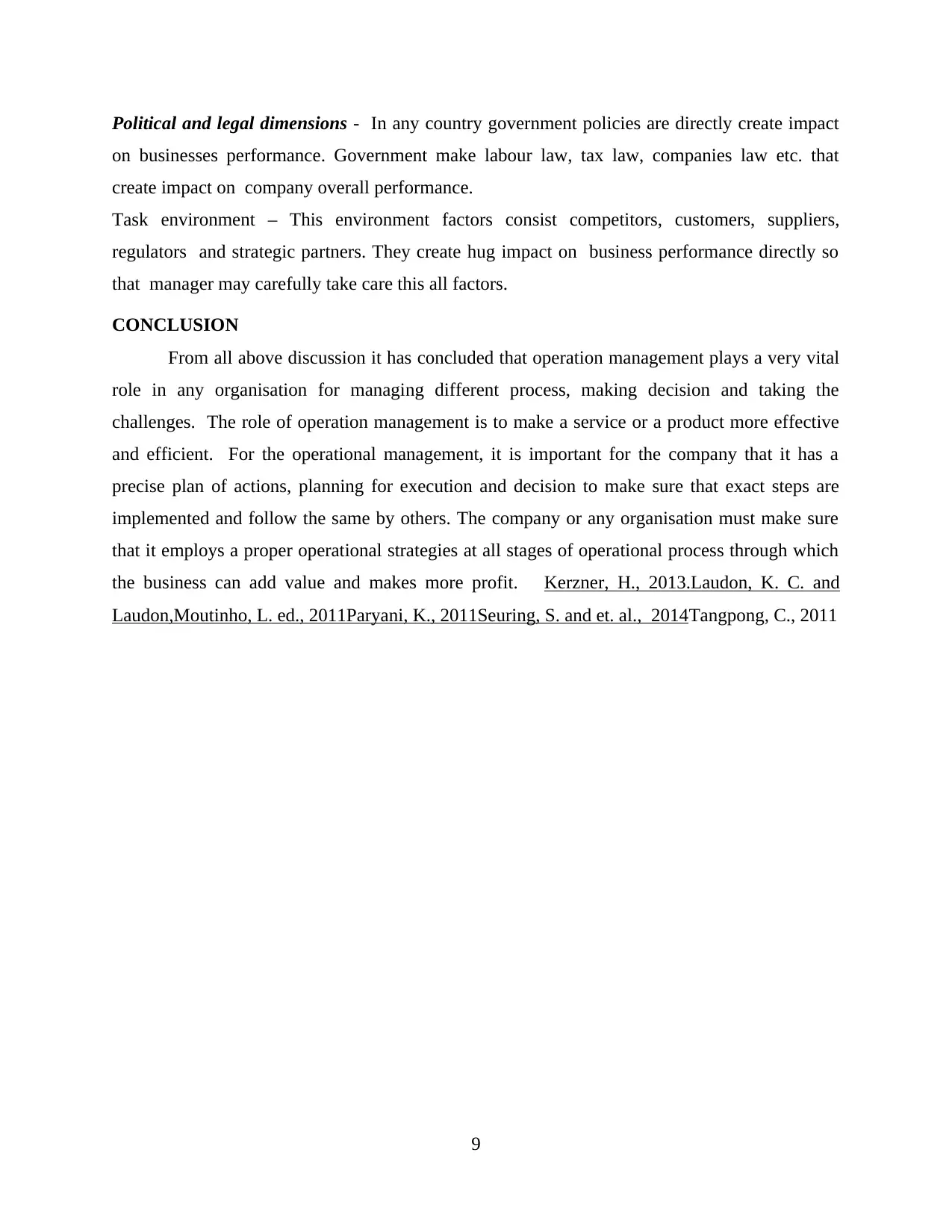
Political and legal dimensions - In any country government policies are directly create impact
on businesses performance. Government make labour law, tax law, companies law etc. that
create impact on company overall performance.
Task environment – This environment factors consist competitors, customers, suppliers,
regulators and strategic partners. They create hug impact on business performance directly so
that manager may carefully take care this all factors.
CONCLUSION
From all above discussion it has concluded that operation management plays a very vital
role in any organisation for managing different process, making decision and taking the
challenges. The role of operation management is to make a service or a product more effective
and efficient. For the operational management, it is important for the company that it has a
precise plan of actions, planning for execution and decision to make sure that exact steps are
implemented and follow the same by others. The company or any organisation must make sure
that it employs a proper operational strategies at all stages of operational process through which
the business can add value and makes more profit. Kerzner, H., 2013.Laudon, K. C. and
Laudon,Moutinho, L. ed., 2011Paryani, K., 2011Seuring, S. and et. al., 2014Tangpong, C., 2011
9
on businesses performance. Government make labour law, tax law, companies law etc. that
create impact on company overall performance.
Task environment – This environment factors consist competitors, customers, suppliers,
regulators and strategic partners. They create hug impact on business performance directly so
that manager may carefully take care this all factors.
CONCLUSION
From all above discussion it has concluded that operation management plays a very vital
role in any organisation for managing different process, making decision and taking the
challenges. The role of operation management is to make a service or a product more effective
and efficient. For the operational management, it is important for the company that it has a
precise plan of actions, planning for execution and decision to make sure that exact steps are
implemented and follow the same by others. The company or any organisation must make sure
that it employs a proper operational strategies at all stages of operational process through which
the business can add value and makes more profit. Kerzner, H., 2013.Laudon, K. C. and
Laudon,Moutinho, L. ed., 2011Paryani, K., 2011Seuring, S. and et. al., 2014Tangpong, C., 2011
9
⊘ This is a preview!⊘
Do you want full access?
Subscribe today to unlock all pages.

Trusted by 1+ million students worldwide
1 out of 14
Related Documents
Your All-in-One AI-Powered Toolkit for Academic Success.
+13062052269
info@desklib.com
Available 24*7 on WhatsApp / Email
![[object Object]](/_next/static/media/star-bottom.7253800d.svg)
Unlock your academic potential
Copyright © 2020–2025 A2Z Services. All Rights Reserved. Developed and managed by ZUCOL.





